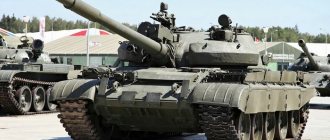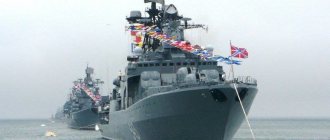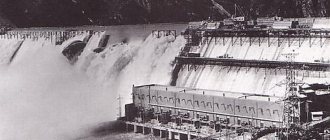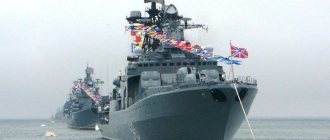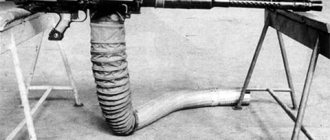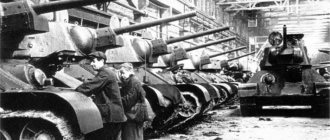The Cold War was a conflict between the USSR and the United States without open hostilities that lasted from March 5, 1946 to February 1, 1992.
Both countries aspired to become the most powerful nation in the world. The task of the USSR was to spread the ideas of communism and establish socialism. The US fought against communism and tried to contain socialism.
The Cold War began on March 5, 1946 with a speech by Winston Churchill, the Prime Minister of Great Britain. At Westminster College in Fulton, Missouri, USA, he called for the creation of an American-English alliance to prevent the spread of communism.
The war ended with the collapse of the USSR and the collapse of socialism. Therefore, the USA won.
Why is it called “cold”?
The Cold War is called because the US and USSR troops did not conduct military operations with each other.
Initially, the concept of “Cold War” was invented and used by the English writer George Orwell in the article “You and the atomic bomb” (1945).
Orwell wrote that the creation of the atomic bomb would lead to a permanent “cold war” between neighbors. That is, there will be no full-scale wars and peace will seem to reign, which, due to the presence of atomic weapons, will not feel like peace.
Officially, the conflict between the USSR and the USA was called the “Cold War” by US Presidential Advisor Bernard Baruch in 1947.
Since there was no military action, countries used other means to achieve victory:
- Arms race (development, production and accumulation of nuclear and other weapons and military equipment at an accelerated pace).
- Formation of military blocs of countries (NATO, Council for Mutual Economic Assistance, Warsaw Pact Organization).
- Support for communist and, conversely, anti-communist regimes in other countries.
Union nuclear weapons
In 1949, the USSR successfully conducted the first tests of a nuclear bomb at the Semipalatinsk test site, which was immediately announced by all Western media. The creation of the RDS-1 (nuclear bomb) became possible largely thanks to the actions of Soviet intelligence, which also penetrated the secret test site in Los Alamossa.
Such a rapid creation of nuclear weapons came as a real surprise to the United States. Since then, nuclear weapons have become the main deterrent to direct military conflict between the two camps. The precedent in Hiroshima and Nagasaki showed the whole world the terrifying power of the atomic bomb. But in which year was the Cold War the most brutal?
What are the causes of the Cold War?
The main reason was the contradictions that arose between the countries that won the Second World War (USSR, America and England). There were contradictions in the spheres of politics, economics and ideology.
Political reasons
- The struggle between the communist regime and the democratic one. According to Churchill, communist countries, including the USSR first, create totalitarianism, that is, an undemocratic regime in the country. The politician also believed that the USSR was striving for world domination.
- Each victorious country feared that the former ally would force other countries to follow their policies.
- Contradictions between the USSR and the USA at the diplomatic level. Their inability to agree on a post-war world order (disputes during the creation of the United Nations).
Economic reasons
- The struggle for markets, military bases and oil.
- At that time, ideas of geopolitical control were actively developing. That is, the more territory, the stronger the country. Therefore, the countries of the anti-Hitler coalition were in no hurry to withdraw their troops from other states. The withdrawal of troops meant a loss of control over territory and resources.
Ideological reasons
- Each victorious country preached its own ideas. England accused the USSR of imposing communist methods and ideas on other countries and interfering in their domestic politics.
- Stalin believed that Churchill was trying to establish his dominance in the world.
Prerequisites for the conflict
The victory over Nazi Germany in World War II forced the USSR, the USA and Western countries to return to the problem of the conflict between the capitalist and socialist political systems of the state. The existing contradictions were intensified by the ambitions of politicians who want to strengthen their position, taking advantage of the weakened state of most countries after the bloody war.
Former allies feared the strengthening of the positions of the Soviet Union and the spread of ideological and political theories providing for the transition of private property to state property. The official beginning of the conflict is considered to be Churchill's speech in Fulton. On March 5, 1946, the politician, in response to the Soviet Union’s refusal to withdraw military forces from Iran, proposed creating an alliance of Anglo-Saxon countries to counter the ideas of communism. The proposal received support from the United States, which pursued the goal of gaining military and economic superiority over the enemy.
Beginning and stages of the Cold War
The Cold War can be divided into five stages:
- March 5, 1946–1955: beginning of the war and the arms race.
- 1955–1962: Relations between the USSR and the USA deteriorate, contradictions reach their climax, and a nuclear disaster almost occurs.
- 1963–1979: policy of détente, period of peace agreements.
- 1979–1987: new aggravation, intensification of the arms race.
- 1987–1992: collapse of the USSR, end of the Cold War.
First stage 1946–1955
Churchill's Fulton speech 1946
Winston Churchill's speech at Westminster College in Fulton, Missouri, USA marked the beginning of the Cold War. He proposed creating an American-British alliance to fight against war and tyranny.
By war, Churchill meant a possible future war that would occur if weapons (the atomic bomb) were “monopoly possessed by certain communist or neo-fascist states.”
Tyranny is the control of Moscow (the Communist Party) over the internal affairs of other countries, the party's attempt to seize land and wealth and establish control over people's thoughts.
“I have seen our Russian friends and allies... they admire nothing more than strength, and nothing they respect less than weakness, especially military.” W. Churchill, 1946
Iranian crisis of 1946
There were Soviet and British troops in Iran. Stalin sought to conclude an agreement with the Prime Minister of Iran on the Soviet Union's production of oil in the north of the country for a fee (oil concession).
The presence of Soviet troops in Iran helped Stalin exert forceful pressure on the decision. The US opposed the agreement. US President Harry Truman issued an ultimatum to Stalin to withdraw Soviet troops.
Truman Doctrine of 1947
This is a program about US foreign policy announced by Truman. Basic provisions of the doctrine:
- The US will provide assistance (economic and military) to non-communist regimes and stop Soviet expansion (seizure of territory).
- The United States announces a policy of containing and rejecting socialism, which is being imposed by the USSR.
Marshall Plan 1947–1948
US Secretary of State George Marshall proposes a plan: to pay money to war-stricken countries so that the crisis does not force them to turn to the Communists for help.
Berlin crisis 1948–1949
The Marshall Plan provided support for West Berlin, which was located in territory economically dependent on Soviet troops. In response to this, the USSR banned all communication with West Berlin, except by air.
The United States organized an “air bridge”, delivering food and goods to West Berlin using airplanes.
The blockade of the western part of the city continued until the division of Germany in 1949 into two states - the Federal Republic of Germany (Federal Republic of Germany, capital Bonn) and the GDR (German Democratic Republic, capital Berlin). The FRG was in territory occupied by British, American and French troops, the GDR was under the control of Soviet troops.
Creation of Comecon and NATO
In response to the Marshall Economic Plan, the socialist countries, at the initiative of the USSR, create the Council for Mutual Economic Assistance. The main goal of the organization: mutual assistance in the post-war crisis, exchange of scientific and technical experience. The council existed until 1991.
On April 4, 1949, Western states led by the United States create the North Atlantic Treaty Organization (NATO). According to the agreement, an attack on one of the NATO member countries would mean aggression against all of them.
Arms race 1950s
The USA and the USSR sought to surpass each other in scientific and technical terms, to develop and accumulate as many weapons and military equipment as possible. The goal is to exert forceful pressure under the threat of using this weapon.
On August 29, 1949, the USSR successfully tests an atomic bomb. Now both powers have nuclear weapons.
In 1957, the USSR was the first to launch an artificial satellite into space. On April 12, 1961, the first person flew into space - Soviet citizen Yuri Gagarin.
In July 1969, American Neil Amstrong was the first to land on the Moon.
Korean War 1950–1953
Hostilities took place between North and South Korea. At the same time, North Korea (DPRK) was supported by the USSR and China, and South Korea by the USA.
Unlike the United States, the Soviet Union did not send troops to Korea; assistance was provided with ammunition and military equipment.
Second stage 1955–1962
Education of the Department of Internal Affairs 1955
The socialist states of Europe (including the USSR) form the Warsaw Pact Organization. According to this treaty, countries undertake to provide each other with military assistance in the event of an attack on one of them. The organization existed until 1991.
Anti-communist uprisings
Many countries were unhappy with the establishment of communism. Uprisings occurred in Czechoslovakia, East Germany and Hungary. Soviet troops suppressed them.
Suez crisis 1956
A new government is established in Egypt (G. A. Nasser), which announces the transfer of the Suez Canal to Egyptian ownership (nationalization of the canal). Before this, the channel was controlled by Great Britain.
Great Britain, France and Israel send troops to Egypt. The USSR supports Nasser and forces these states to withdraw their troops.
Vietnam War 1964–1975
The conflict between the USSR and the USA continued during the Vietnam War.
The United States took part in the war effort in support of South Vietnam. The USSR supported the Democratic Republic of Vietnam (in the north), which followed the ideas of socialism.
Berlin Wall
The GDR wanted to separate West Berlin, which was under the control of British, American and French troops, from the rest of the territory.
In order to make the western part of the city an independent political unit, it was decided to build a border around it. On August 13, 1961, the GDR authorities began building a wall around West Berlin, 106 km long and more than 3.5 meters high.
Cuban Missile Crisis 1962
In October and November 1962, the whole world was facing the threat of a third nuclear war. The USSR deploys nuclear missiles in Cuba, the USA in Turkey. After 38 days of tense negotiations, both countries withdraw their missiles.
Read more about the Cuban missile crisis.
Third stage 1963–1979
"Prague Spring" in Czechoslovakia 1968
In 1968, the leadership of Czechoslovakia pursued a course of reforms called the “Prague Spring”. According to other countries, these reforms could lead to the establishment of a bourgeois-democratic system.
Five countries participating in the Warsaw Pact (USSR, Bulgaria, Hungary, East Germany and Poland) sent troops into Czechoslovakia on August 21, 1968. The goal was to stop reforms that undermine the ideas of socialism.
Treaty between the USSR and Germany
In 1970, the USSR and Germany signed an agreement. The countries agreed to resolve disputes through peaceful negotiations and respect the borders of European states.
SALT I Treaty
In May 1972, Richard Nixon meets with Leonid Brezhnev in Moscow. They sign the Strategic Arms Reduction Treaty (SALT I). This was the first attempt by the USSR and the USA to establish contact.
Meeting on Security and Cooperation 1975
In 1975, the Conference on Security and Cooperation in Europe takes place in Helsinki. The final act of this meeting is signed by 35 countries, including the USA and the USSR. This was an important step to defuse relations.
Fourth stage 1979–1987
Afghan War 1979–1989
The USSR gets involved in a civil war in Afghanistan. The Soviet Union provides support to the People's Democratic Party of Afghanistan. The Islamic opposition that opposed this party is supported by the United States.
Read more about the Afghan war.
Meetings between Gorbachev and Reagan
In October 1986, negotiations were held between Soviet leader Mikhail Gorbachev and US President Ronald Reagan in Reykjavik. The issue of nuclear disarmament was discussed at the meeting.
In 1987, the USSR and the USA entered into an agreement on intermediate- and shorter-range missiles. The parties agreed to destroy all nuclear weapons of this class.
Fifth stage 1988–1991
"Velvet Revolutions" 1989
In 1989, “velvet revolutions” took place in socialist countries. As a result, socialist regimes collapse in Poland, Czechoslovakia, Hungary, East Germany, Bulgaria and Albania.
Meeting between Gorbachev and Bush Sr.
In 1989, Gorbachev and US President George W. Bush meet in Malta. The USSR stated that it was ready to cooperate with America.
Fall of the Berlin Wall
On November 9, 1989, the GDR authorities open the border: everyone can leave and enter the GDR. By November 1990, almost the entire wall had been demolished.
The peaceful fall of the wall symbolized the end of the Cold War.
Collapse of the USSR
On December 26, 1991, the USSR collapsed. The Soviet Union ceased to exist.
Read more about the collapse of the USSR.
Declaration of Russia and the USA
On February 1, 1992, Russian President Boris Yeltsin and US President George W. Bush sign the Camp David Declaration.
It says that “Russia and the United States do not consider each other as potential adversaries...”. This document officially ended the Cold War.
Spheres of influence
One of these was installed in Poland. At the same time, the previous Polish government was located in London and considered itself legitimate. supported him, but the Communist Party, elected by the Polish people, de facto ruled the country. At the Yalta Conference, this issue was especially acutely considered by the parties. Similar problems were also observed in other regions. The peoples liberated from Nazi occupation created their own governments with the support of the USSR. Therefore, after the victory over the Third Reich, the map of the future Europe was finally formed.
The main stumbling blocks of the former allies in the anti-Hitler coalition began after the division of Germany. The eastern part was occupied by Soviet troops, the Western territories were proclaimed, which were occupied by the Allies and became part of the Federal Republic of Germany. Infighting immediately began between the two governments. The confrontation ultimately led to the closure of the borders between Germany and the GDR. Espionage and even sabotage actions began.
Spy games
The espionage intrigues of the Cold War were widely reflected in art. The secret services went to all sorts of tricks to stay one step ahead of their opponents. One of the most typical cases is Operation Confession, which is more like the plot of a spy detective story.
Even during the war, the Soviet scientist Lev Termin created a unique transmitter that did not require recharging or a power source. It was a kind of perpetual motion machine. The listening device was named “Zlatoust”. The KGB, on Beria’s personal orders, decided to install “Zlatoust” in the US Embassy building. For this purpose, a wooden shield was created depicting the coat of arms of the United States. During the visit of the American ambassador, a ceremonial assembly was held at the children's health center. At the end, the pioneers sang the US anthem, after which the touched ambassador was presented with a wooden coat of arms. He, unaware of the trick, installed it in his personal account. Thanks to this, the KGB received information about all the ambassador’s conversations for 7 years. There were a huge number of similar cases, open to the public and secret.
"Black Saturday"
The world suffered the greatest blows during the Cold War on October 27, Saturday. On this day, an American U-2 reconnaissance aircraft flew over Cuba and was shot down by Soviet anti-aircraft gunners. Within a few hours, this incident became known in Washington.
The US Congress advised the President to launch an invasion immediately. The President decided to write a letter to Khrushchev, where he repeated his demands. Nikita Sergeevich responded to this letter immediately, agreeing to them, in exchange for a US promise not to attack Cuba and to remove missiles from Turkey. In order for the message to reach as quickly as possible, the appeal was made via radio. This is where the Cuban crisis ended. From then on, the tension in the situation began to gradually decrease.
Aggravation of the situation
Immediately after this, the US military was placed on high alert. Kennedy held an emergency meeting. A number of senior officials called on the President to immediately launch an invasion of Cuba. In the event of such a development of events, the Red Army would immediately launch a nuclear missile strike on the landing force. This could well lead to a worldwide conflict. Therefore, both sides began to look for possible compromises. After all, everyone understood what such a cold war could lead to. Years of nuclear winter were definitely not the best prospect.
The situation was extremely tense, everything could change literally at any second. According to historical sources, at this time Kennedy even slept in his office. As a result, the Americans put forward an ultimatum - to remove Soviet missiles from Cuba. Then the naval blockade of the island began.
Khrushchev held a similar meeting in Moscow. Some Soviet generals also insisted not to give in to Washington's demands and, if necessary, to repel an American attack. The main blow of the Union could not have been in Cuba at all, but in Berlin, which was well understood in the White House.

